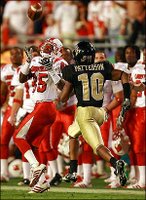My Two Cents on Character Flaws
I’m intrigued by the discussion Rob started on flawed characters in LDS fiction, so here’s my two cents on the topic.
I think LDS publishers and readers are open to flawed main characters. In fact, I think they want characters to have flaws and quirks. Dudley Do-Right is a cartoon, not meant to be realistic, and unless we’re trying to be funny, none of us writers are laboring to create the literary equivalent of Dudley. Realistic heroes and heroines have flaws.
I remember getting evaluations back on a manuscript I’d submitted and being pleased when I saw comments about the main character’s shortcomings. I’d worried about making him too white-hat good guy-ish, and was glad he’d come across as imperfect. When you combine realistic flaws with courage and determination in the face of adversity, you end up with a character readers can relate to and root for.
Are writers who choose to write for the LDS market limited in the kinds of flaws they can give their characters and how the characters deal with those flaws? Um, yeah. Of course. How in the world could it be otherwise? If LDS fiction didn’t have anything that set it apart from mainstream fiction, then why bother to write it or read it? One thing a reader knows when picking up a novel from a mainstream LDS publisher is that the story will not glorify evil. Evil things may happen. People may make bad choices. But evil will not be made to look appealing, glamorous, or consequence-free.
From FHL in the comment trail on Rob's blog:
How flawed is acceptable? Tough call. I suppose the guideline I'd set for myself is : will my protagonist tempt the reader to try out his flaws? Does he accept / embrace his flaws, or try to improve?
Good comment, FHL. I think the main character in an LDS novel needs to make positive progress. I’m not saying every LDS novel needs to be a conversion story, but a flawed protagonist ought to be better at the end than he was at the beginning. Why? A character needs to change over the course of a novel. If you’re writing LDS fiction, the character arc needs to move toward positive change. As Keith Fisher said in the comment trail:
I think that LDS fiction (because it is LDS fiction) should show the characters becoming better. After all, that is the message of the Savior and should be the purpose of our writing.
Some people would complain that saying a flawed character in an LDS novel needs to improve isn’t “realistic.” I disagree. Sure, change for the better can be portrayed in an unrealistic manner, but ANY type of character development can be done badly. And when I say I think positive change needs to happen, I'm not saying LDS authors should be writing just one kind of story. Character change can be subtle or overt. Maybe the flawed character undergoes a life-changing conversion. Maybe he/she just ends up a little braver, a little stronger, a little more seasoned and refined, a little more knowledgeable, a little more compassionate, a little more patient—the possibilities are endless.
Here are two examples of flawed protagonists from recent LDS novels:
In The Operative, by Willard Boyd Gardner, Kam Daniels is a boozing ex-cop who ran out on his wife, Rhiana, when he couldn’t cope with his guilt over his inadvertent role in a tragic accident. At the opening of the novel, Kam gets drawn into helping Rhiana rescue a kidnapped operative in Yemen. Kam wants to reconcile with Rhiana, but he struggles to reach out and respond to her, he does and says dumb things, he hides behind jokes. But he’s determined, courageous and compassionate. At the end of the book, he isn’t converted or flaw-free, but he’s a better man than he was and he’s on the right path.
In Redemption Road, by Toni Sorenson Brown, Lana Carter has damaged her life with a string of poor decisions. Inactive in the church and with two failed marriages behind her, Lana tries to hide from her painful past and problems, but throughout the course of the book, she moves gradually toward redemption and peace as she loves and serves the people of Kenya—particularly one little boy.
Lana and Kam are both interesting, flawed, multi-layered protagonists.












